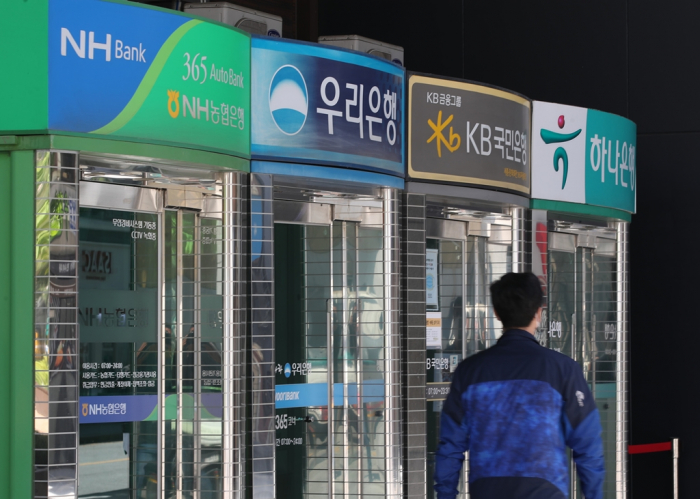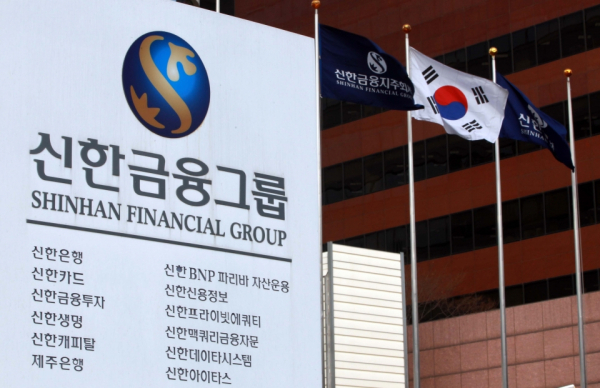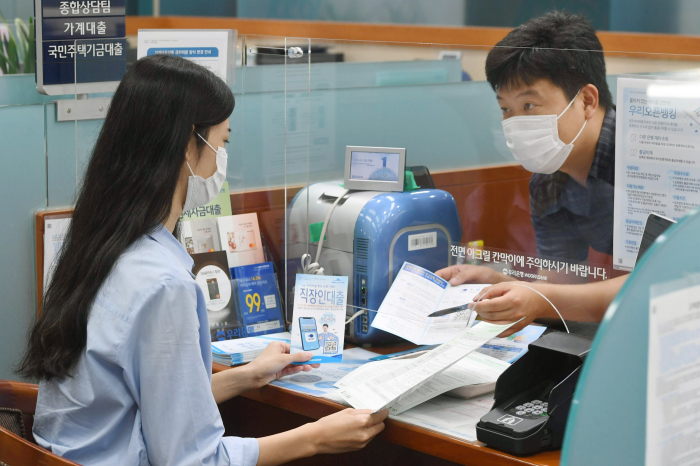Banking & Finance
Korean bank profits at record-high as borrowers struggle under debt
Banks could be in trouble if massive borrowing turns into bad debt with interest rate hikes, analysts warn
By Feb 10, 2022 (Gmt+09:00)
3
Min read
Most Read
S.Korea's LS Materials set to boost earnings ahead of IPO process


Samsung Heavy Industries succeeds autonomous vessel navigation


Samsung shifts to emergency mode with 6-day work week for executives


Hankook Tire buys $1 bn Hanon Systems stake from Hahn & Co.


Korean battery maker SK On expects business turnaround in H2



South KoreaŌĆÖs major banks posted record earnings last year, boosted by higher interest income amid the central bankŌĆÖs easing monetary bias, which in turn made retail borrowers struggle under growing debt.
The big lendersŌĆÖ strong balance sheet, however, could deteriorate this year and next if financially weak households and smaller companies fail to repay borrowings with rapidly rising interest rates, analysts warn.
Shinhan Financial Group Co. on Wednesday reported that its 2021 net profit increased 17% from the previous year to a record 4.02 trillion won ($3.36 billion), largely driven by handsome interest gains at its flagship Shinhan Bank and non-bank business gains such as commission fees.
On the same day, Woori Financial Group said its net income last year almost doubled to 2.59 trillion won, citing similar reasons.
Their strong earnings reports came a day after KB Financial Group Inc., now the countryŌĆÖs top lender, said its 2021 net profit increased 27% from a year earlier to 4.41 trillion won despite heavy provisioning against higher severance pays for its employees.
Compared with their pre-pandemic results in 2019, the three biggest financial holding companies in Korea saw their bottom line improve by a third.

REELING FROM HIGHER BORROWING
The financial institutionsŌĆÖ stellar performance came as a result of aggressive borrowing by smaller enterprises and individuals that took advantage of ultra-low interest rates to fight the economic slowdown and invest in riskier assets such as stocks and property.
Outstanding loans from the countryŌĆÖs five largest banks ŌĆō Kookmin, Shinhan, Hana, Woori and NongHyup ŌĆō stood at 1,366 trillion won at the end of January this year, up 19.2% from two years earlier. By contrast, deposits at the five banks totaled 1,789 trillion won, up 17.4% over the same period.
BanksŌĆÖ increased profitability stands in stark contrast to the worsening situation for retail borrowers, who find their debt repayment increasingly harder as central banks around the world start to shift their policy priority from supporting economic growth to taming rising inflationary pressure via interest rate hikes.
In January, KoreaŌĆÖs central bank returned its policy rate to a pre-pandemic level by increasing the base rate for the second time in three months to 1.25% and signaled further hikes to cool the overheating housing market and keep soaring household debt in check.
The Bank of Korea is widely expected to raise the benchmark rate at least twice this year in line with similar moves by its global peers, notably the US Fed, which is moving faster than expected to tighten its monetary stance.

According to the BOK, the weighted average interest rate of household loans by local banks stood at 3.61% a year as of November 2021, up 0.65 percentage point higher from 2.96% two years earlier.
Industry data showed the balance of household loans at the five major banks was 707.69 trillion won at the end of January, up 15.7% from two years ago. Of the total amount, household credit with floating interest rates stood at 137.4 trillion won, up 25% over the same period, making borrowers more vulnerable to interest rate hikes.
ŌĆ£Let alone local banks, secondary financial institutions such as savings banks also made big money in the past couple of years. However, massive loans extended to smaller firms and individuals could easily turn into bad debt when interest rates are on an ascending trend. If this happens, banks could be in trouble,ŌĆØ said a local bank executive.
Write to Dae-Hun Kim at daepun@hankyung.com
In-Soo Nam edited this article.
More to Read
-
 Central bankingBOK restores interest rates to pre-pandemic level
Central bankingBOK restores interest rates to pre-pandemic levelJan 14, 2022 (Gmt+09:00)
3 Min read -
 Banking & FinanceMoney moves back to safe assets in Korea amid rising interest rates
Banking & FinanceMoney moves back to safe assets in Korea amid rising interest ratesDec 20, 2021 (Gmt+09:00)
3 Min read -
 Household loansMortgage loan growth slows to near four-year low in November
Household loansMortgage loan growth slows to near four-year low in NovemberDec 09, 2021 (Gmt+09:00)
2 Min read
Comment 0
LOG IN


